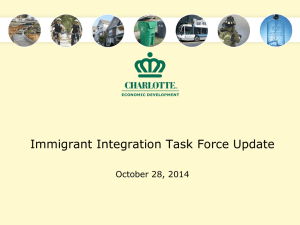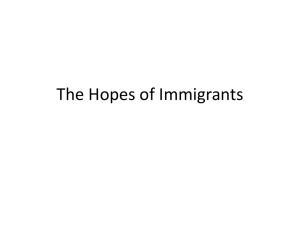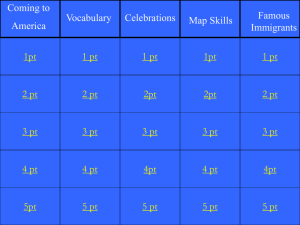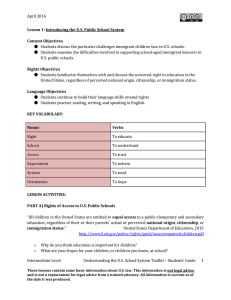Translocations: Migration and Social Change An Inter-Disciplinary Open Access E-Journal 2009-0420 _____________________________________________________________________
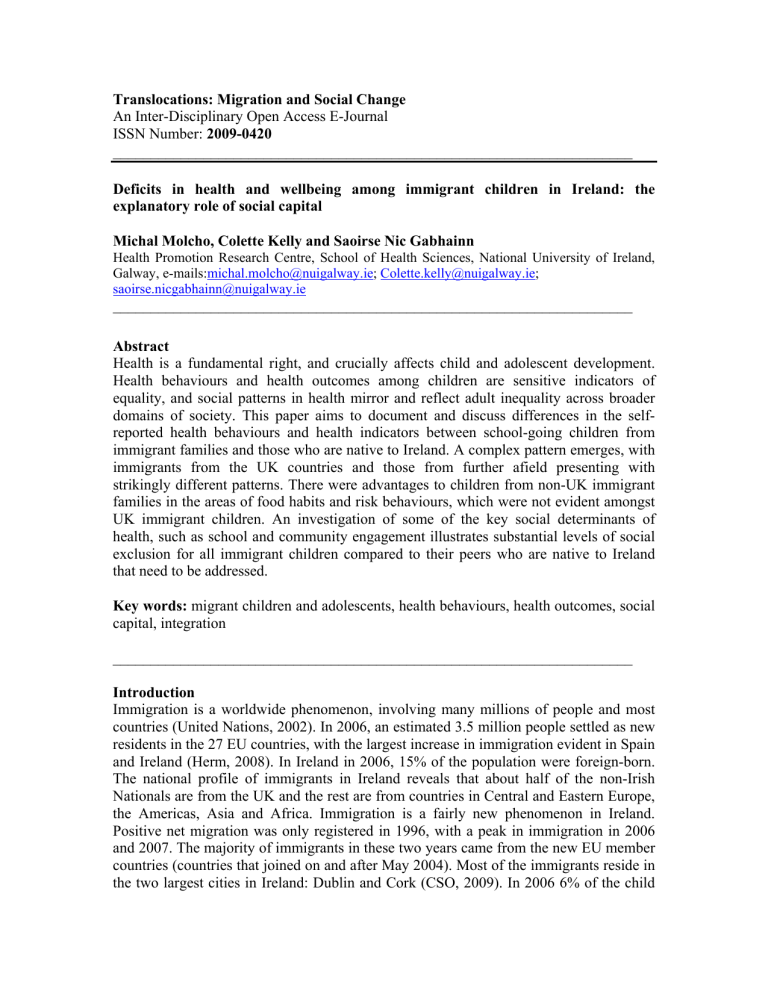
Translocations: Migration and Social Change
An Inter-Disciplinary Open Access E-Journal
ISSN Number: 2009-0420
_____________________________________________________________________
Deficits in health and wellbeing among immigrant children in Ireland: the explanatory role of social capital
Michal Molcho, Colette Kelly and Saoirse Nic Gabhainn
Health Promotion Research Centre, School of Health Sciences, National University of Ireland,
Galway, e-mails: michal.molcho@nuigalway.ie
; Colette.kelly@nuigalway.ie
; saoirse.nicgabhainn@nuigalway.ie
_____________________________________________________________________
Abstract
Health is a fundamental right, and crucially affects child and adolescent development.
Health behaviours and health outcomes among children are sensitive indicators of equality, and social patterns in health mirror and reflect adult inequality across broader domains of society. This paper aims to document and discuss differences in the selfreported health behaviours and health indicators between school-going children from immigrant families and those who are native to Ireland. A complex pattern emerges, with immigrants from the UK countries and those from further afield presenting with strikingly different patterns. There were advantages to children from non-UK immigrant families in the areas of food habits and risk behaviours, which were not evident amongst
UK immigrant children. An investigation of some of the key social determinants of health, such as school and community engagement illustrates substantial levels of social exclusion for all immigrant children compared to their peers who are native to Ireland that need to be addressed.
Key words: migrant children and adolescents, health behaviours, health outcomes, social capital, integration
_____________________________________________________________________
Introduction
Immigration is a worldwide phenomenon, involving many millions of people and most countries (United Nations, 2002). In 2006, an estimated 3.5 million people settled as new residents in the 27 EU countries, with the largest increase in immigration evident in Spain and Ireland (Herm, 2008). In Ireland in 2006, 15% of the population were foreign-born.
The national profile of immigrants in Ireland reveals that about half of the non-Irish
Nationals are from the UK and the rest are from countries in Central and Eastern Europe, the Americas, Asia and Africa. Immigration is a fairly new phenomenon in Ireland.
Positive net migration was only registered in 1996, with a peak in immigration in 2006 and 2007. The majority of immigrants in these two years came from the new EU member countries (countries that joined on and after May 2004). Most of the immigrants reside in the two largest cities in Ireland: Dublin and Cork (CSO, 2009). In 2006 6% of the child
population were non-Irish nationals (Nolan & Maitre, 2008). Of these children, 32% were from the UK, 8% from Poland, 8% from Nigeria and 7% were from the USA. The rest of the non-Irish national children are from a range of different countries (Hanafin et al.,
2008). UK immigrants, therefore, are the single largest group of immigrants in Ireland.
Additional to being the most sizable group of immigrants in Ireland, it is estimated that many of those immigrants are of Irish descent, returning to Ireland after years, or generations, in the UK. As such, this group of children immigrants is potentially different from other immigrant groups and deserves special attention.
While the process of immigration is often imposed, as in the case of those who seek asylum, this is more likely for children for whom decisions are made by parents or relatives. As with adults, child immigrants leave their homeland and settle in a new country, often with different norms and values, and need to adapt to a sometimes markedly different culture and socioeconomic conditions, often facing discrimination and racism (Pantin et al., 2003; Berry, 1997; Ward, Bochner, & Furnham, 2001). It is therefore important to study the experiences of immigrant children.
Most of the studies on this age group of migrants have been conducted in the US and
Canada, with fewer studies from Europe (Stevens et al., 2003; Vollebergh et al., 2005;
Storhmeier and Schmitt-Rodermund, 2008). Studies on child immigrants have mostly described their socio-demographics circumstances, involvement in risk behaviours, language fluency, school performance and mental health as compared to those children who are native to the country where the studies are conducted, the destination countries.
The literature on child immigrants points towards the overall poor living circumstances experienced by this group. A review of immigrant children in the US revealed that 54% of immigrant children live in low-income households compared to 36% of children native to the US, with parental wages being substantially lower than those native to the US.
Immigrant children are also more exposed to food insecurity, crowded housing, and are less likely to have medical insurance (The Urban Institute, 2006; Hernandez et al., 2008;
Vollebergh et al., 2005).
Existing evidence on the health of immigrant children is inconclusive. Some studies have reported that immigrant children experienced higher levels of psychosomatic symptoms and reported lower levels of life satisfaction, self-reported health, social integration and victimisation compared to their peers who were native to Italy (e.g., Vieno et al., 2009), and that they are more likely to report behavioural problems, attention problems, delinquent behaviours and aggressive behaviour than their peers who are native to a range of destination countries (Bengi-Arslan et al., 1997; Janssen et al, 2004; Vollebergh et al., 2005). Others have reported that immigrant children are no different than their peers (Ma, 2002; Davies and McKelvey, 1998; Blake et al., 2001; Beiser at al., 2002). A third stream of studies have reported that immigrant children fare better in relation to psychological and socio-cultural adaptation (Beiser et al., 2002; Crosnoe, 2005; Harker,
2001; Mullan Harris, 1999; Acevedo-Garcia et al., 2005; Georgiades et al., 2006;
Sampson, Morenoff, & Raudenbush, 2005), despite frequently being exposed to poorer
socio-economic circumstances (Beiser et al., 2002; Heisz & McLeod, 2004;
Schellenberg, 2004).
The contradictory nature of the evidence also extends to involvement in risk behaviours: studies in the US and Canada have documented that immigrant children, even when living in families with lower socioeconomic status, are less likely to smoke, drink, use drugs or engage in delinquent behaviour (Georgoades, 2006; Haris, 2004); however, other studies have suggested the opposite (Isralowitz and Slonim-Nevo, 2002; Bengi-
Arslan et al., 1997; Pawliuk et al., 1996).
Another aspect of the lives of immigrant children that has been explored is academic achievement and attainment. Here, too, findings vary – often based on countries of origin and countries of destination. In general, students from low- and middle-income countries and from politically unstable countries tend to do worse in school compared to their peers in the destination countries (Levels, Dronkers and Kraaykamp, 2008). However, in many
Western countries, students of Asian background have better academic achievements than their peers who are native to the destination countries. This has been reported in
Finland (Liebkind et al., 2004), Australia (Cardak and McDonald, 2004) and the United
States (Glick and White, 2004). Latino students in the US, on the other hand, have rather consistently been found to perform worse in school (Harris et al., 2008). To complicate things further, immigrant youth in Sweden are disproportionately represented among both high-achieving students and among early school leavers (Westin, 2003).
In Ireland, Molcho et al. (2008) examined general health, smoking, use of alcohol and other substances, diet and food behaviour, physical activity and sedentary behaviour, injuries and bullying among immigrant children and their peers native to Ireland and found stark differences by origin; specifically between those the UK countries and those from other countries. Compared to their peers native to Ireland, UK immigrant girls were more likely to report frequent headaches, skipping breakfast and dieting compared girls from Ireland; and both boys and girls were less likely to report positive school perceptions. Non-UK immigrant children were less likely to report drinking alcohol, history of drunkenness and smoking; more likely to report frequent consumption of fruits and vegetables, but were less likely to report positive relationships with their classmates.
Both groups of immigrant children (from the UK and non-UK) were less likely to report feeling very happy, high life satisfaction and frequent physical activity, and more likely to report that they had been bullied in school in the last couple of months.
Two of the building blocks of social capital for children are sense of cohesion in the local residential area and in school (Coleman, 1988; Putnam, 1993; Kawachi et al., 1999).
Although there is no universal definition of social capital, it is generally agreed that it includes trust, social participation and norms of reciprocity (Helliwell & Putnam, 2004;
Kawachi et al, 2004; Poortinga, 2006). Trust, participation and sense of belonging in both school and the local area are, therefore, relevant to creating high-perceived levels of social capital. A high level of social capital, in turn, acts as a social strength, protecting individuals from involvement in antisocial behaviour and increasing wellbeing (Sampson
& Groves, 1989; Bellair, 1997; Warner & Rountree, 1997). Among immigrant children in
Canada, sense of belonging and integration was associated with fewer psychological and behavioural problems (Gaudet et al., 2005).
Level of integration in school and in the local area, are important in adolescent lives.
Sense of belonging to local area can assist in preservation of identity (Altman and Low,
1992). Positive perceptions of local area were found to act as resilience factors during times of identity crisis that occur during periods of transition such as adolescence (Hay,
1998) and may also be relevant to other transitions such as immigration. Hence, this paper investigates the potential protective role of perceptions of local area on the health and well being of immigrant children.
Using data from the 2006 Irish Health Behaviour in School-Aged Children (HBSC) study, this paper sets out to examine confounders for the differences in health and wellbeing between immigrants and their peers native to Ireland that were previously reported by Molcho et al. (2008). We examine if level of integration in school and in the local area can assist in explaining the differences between immigrant children and their peers native to Ireland in relation to health and wellbeing. Given that some of the UK child immigrants could be of Irish families returning to Ireland, which can influence their sense of belonging and integration, this group is analysed separately.
The aim of the analysis in this paper is to explore the levels of perceived health and wellbeing among immigrant children and to investigate the extent that differences between immigrants and their peers native to Ireland may be explained by differences in social capital. It is hypothesised that:
1.
immigrant children are less likely to experience high levels of social capital;
2.
immigrant children experiencing high levels of social capital are more likely to report similar levels of health, life satisfaction and happiness to those reported by their peers native to Ireland.
Methods
Ethical approval for this study was granted by the NUI Galway Research Ethics
Committee.
Study Population and Procedures
A school-based anonymous survey was conducted during Spring 2006 according to a common, cross-national, HBSC research protocol (Currie et al., 2008). Primary and postprimary schools in Ireland were randomly selected using a two-stage sampling process to achieve a representative sample of school going children aged 10-17 years. The sample was stratified by regional location. Statistical criteria specified that the sample would be sufficient to provide confidence intervals of +/-3% for representative estimates with sample design effects no more than 1.2 times greater than would be obtained from a simple random sample. A total of 10,334 school children were sampled from 215 schools, with a response rate of 63% at the school level and 83% at the individual child level.
The current analyses are based on a sub-sample of self-identified immigrant children.
Children were identified as immigrants if they were either born outside of Ireland or if
both parents were born outside of Ireland. In order to take into account potential sociodemographic differences between the immigrant population and the general population in terms of geographical location, or socio-demographic characteristics, immigrant children were matched to a sub-sample of respondents who were native to Ireland. All respondents in the comparison group were matched by gender, age and social class, resulting in a subsample with similar socio-demographic characteristics. Where possible, the matching was done within the same classroom (69%). When this was not possible, a matched respondent was sought within the same school (8%) or within the geographical region
(23%). The paper will mainly focus on the breakdown of the immigrant group into: those for whom either parent is from the UK (UK immigrants), and those for whom neither parent is from the UK (non-UK immigrants). The two groups were similar in size (276
UK immigrants and 286 non-UK immigrants).
Measurement
Family Affluence Scale (FAS)
The Family Affluence Scale (Currie et al., 2008) is an existing measure of material wealth that is based on four indicators of consumption /deprivation (vehicle ownership, bedroom sharing, holiday travel and computer ownership). Scores ranged from 0 to 7, with 0 representing the lowest family affluence and 7 representing the highest. The scores were combined into 3 categories as follows: high (0-3), medium (4-5), and low (6-7).
Health and wellbeing
Self-rated health was assessed by the question ‘Would you say your health is …?’ and the response options were dichotomised at excellent versus good, fair or poor. Self-reported happiness was measured by the question ‘In general, how do you feel about your life at present?’ and the responses were dichotomised at very happy versus quite happy, don’t feel very happy and not happy at all. Children were also asked to rank themselves from 0 to 10 on a life satisfaction ladder (Cantril, 1965). This scale was used to identify those with high life satisfaction (response >6).
Social capital: school and local area perceptions
Using factor analysis, specific dimensions of school and local area were identified, and the following scales were constructed.
Student relationships
Children were asked 3 questions about their relationships with other students in their class. Children were asked how much they agree that students in their class are kind and helpful; that students in their class enjoy being together, and that students in their class accept them as they are, with the response options for each questions being ‘strongly agree’; ‘agree’; ‘neither agree nor disagree’; ‘disagree’; and ‘strongly disagree’. The
Cronbach alpha for this scale was 0.712.
Relationships with teachers
Children were asked 4 questions about their relationships with other teachers. Children were asked how much they agree that their teachers are interested in them; that their teachers encourage them to express their own view; that their teachers treat students
fairly; and that they can get extra help from their teachers if they need it, with the response options ‘strongly agree’; ‘agree’; ‘neither agree nor disagree’; ‘disagree’; and
‘strongly disagree’. The Cronbach alpha for this scale was 0.804.
Scale responses were divided to tertiles indicating low, mid and high levels of positive perceptions towards each dimension.
General school perceptions
Children were asked 5 questions about their general school perceptions. Children were asked how much they agree that the rules in the school are fair; that students are not treated too strictly; that school is a nice place to be in; that they feel belong at school; and that they feel safe at school, with the response options ‘strongly agree’; ‘agree’; ‘neither agree nor disagree’; ‘disagree’; and ‘strongly disagree’. The Cronbach alpha for this scale was 0.787.
Perceptions of local area
Children were asked 5 questions about their local area. These comprised how often they feel that their local area is a good place to live in; that it is safe for young children to play outside; that there are good places to go to; and that they can ask for help from people in their local area, with the response options ‘strongly agree’; ‘agree’; ‘neither agree nor disagree’; ‘disagree’; and ‘strongly disagree’. The Cronbach alpha for this scale was
0.674.
Results
Overall, 5.4% of the sample were classified as immigrant children (n=562) of which 276 were from the UK and 286 from other countries. Table 1 presents the distribution of socio-demographic characteristics among immigrant children. The UK and non-UK immigrant groups were of similar gender and age distribution, however the non-UK group was more likely to reside in an urban setting (p<0.001) and were of lower family affluence (p<0.05) when compared to the UK group.
Tables 2 and 3 present the distributions of the outcome variables and the determinants. In all cases the groups of immigrant children (UK, non-UK and all together) were compared with their respective matched groups of children native to Ireland – their matched peers.
Immigrant children did not significantly differ from their matched peers in relation to reporting excellent health. However, UK immigrant children were less likely to report high life satisfaction compared to their matched peers (p<0.01) although this was not found among the non-UK immigrant group. Children in both immigrant groups (UK and
Non-UK) were less likely to report that they feel very happy with their lives compared to their matched peers (for UK immigrant children p<0.01; for non-UK immigrant children p<0.05). UK immigrants were also less likely to report positive relationships with their classmates (p<0.01), and have overall more negative perceptions towards their school
(p<0.05). Non-UK immigrant children were less likely to report positive relationships with their teachers (p<0.05).
Finally, models examining the potential confounding effects of school and local area perceptions on health and wellbeing were constructed, using hierarchal models of logistic regression. For each outcome variable, the first step simultaneously included immigrant status, gender and age group in order to determine the effect of being an immigrant on the outcome over and above the effect of gender and age. The second step added other sociodemographic variables (family affluence and residential location), and in the third step perceptions of school and local area were also included. Tables 4, 5 and 6 present the findings of these models.
The first set of models examined excellent health. No significant differences were found between both groups of immigrants and their peers native to Ireland, but the importance of self-reported health is such that it deserves further investigation. In both immigrant groups, positive perceptions towards school and local area increased the likelihood of reporting excellent health (p<0.05-p<0.0001). Positive relationships with teachers increased the odds of reporting excellent health in both groups, although this was not found to be statistically significant. Also not significant among non-UK immigrants, was the increased odds for reporting excellent health when positive relationships with classmates were reported. Overall, the addition of school and local area to the model increased the explained variance to 20% among UK immigrants and to 21% among non-
UK immigrants.
The second set of models examined life satisfaction. UK immigrant children were much less likely to report high life satisfaction over and above age and gender. Adding residential location and family affluence to the model increased the explained variance from 4% to 6%. Positive relationships with teachers was the strongest predictor of high life satisfaction among both UK immigrants (p<0.001) and non-UK immigrants (n.s.).
Positive perceptions of the local area also predicted high life satisfaction in both immigrant groups although the results were not statistically significant. Adding the school and local area perceptions increased the explained variance to 17%. That however, did not change the effect of having an immigrant status on reporting high life satisfaction.
Among non-UK immigrants, no significant differences were identified in reported high life satisfaction, with only gender being statistically significantly associated with reporting high life satisfaction.
The third set of models examined happiness. Both UK and non-UK immigrants were much less likely to report feeling very happy over and above gender, age, family affluence and residential location. Among UK immigrants, positive relationships with teachers (p<0.001) and positive perceptions of local area (p<0.001) increased the likelihood of reporting feeling very happy, with the explained variability going up from
11% to 25%. Among non-UK immigrants, most school and local area perceptions, where positive, significantly increased the levels of reported happiness (p<0.05-p<0.001), with explained variance going up from 5% to 28%. However, for both sub-groups of immigrant children, the addition of the school and local area perceptions not only did not decrease the differences between the immigrants and their peers who were native to
Ireland, but actually increased the gap. In the final model for each of the groups, being an
immigrant significantly and substantially decreased the likelihood of a child reporting that they felt very happy.
Discussion
In the past 10 years, Ireland has experienced a substantial increase in incoming migration;
15% of the population in 2006 is reported to be foreign-born. With 6% of children being of foreign nationality, the issue of migrants in society becomes very real in the Irish context. The HBSC Ireland study, using a large nationally representative sample of school-going children, provides a unique opportunity to investigate the experiences of migrant children in Irish society. The data obtained from the 2006 HBSC Ireland survey included information from 562 migrant children, to which a respective number of children native to Ireland were matched by age, gender, parental social class and geographical location. Previous findings that were reported from these data indicated that immigrant children in Ireland were less likely to report high life satisfaction and happiness (Molcho et al., 2008). The current study, using more complex modelling, aimed to explore some of the possible explanations for these differences between migrants and their peers who are native to Ireland in relation to health and wellbeing.
Similar to previous reports (e.g., Vieno et al., 2009), the current study found that fewer immigrant children (those from both the UK and elsewhere) reported high life satisfaction and happiness compared to their peers who were native to Ireland. This study also documented differences in school and local area perceptions. Here, differences were found between the UK and non-UK groups. For example, UK immigrants were less likely to report general positive perceptions towards school and had less positive perceptions of the relationships with other students in their class(es). These differences were not found among non-UK immigrants, who were less likely to report positive relationships with their teachers.
Hierarchical models of logistic regression were used to identify the confounding effect of the different dimensions of school and local area perceptions, following the findings of
Gaudet et al. (2005) according to which, problems in adaptation appear to be strongly moderated by levels of social cohesion and the actual process of adaptation. The measurement scales used to measure school perceptions included relationship with classmates and teacher and general perceptions of the school and the local area, all of which could indicate how well an individual is integrated into society.
Two main questions led this study. First, we wanted to assess whether immigrant children were less likely to experience high levels of social capital. Overall, immigrant children of both groups were less likely to report positive student relationships, but no differences were evident in relation to general school perceptions. While UK immigrant children were similar to their peers native to Ireland in relation to perceptions of local area and relationships with teachers, non-UK immigrant children were less likely to report positive perceptions of both these dimensions, emphasising the differences between the two groups. These findings suggest that both immigrant groups were at risk for social exclusion in their school classes. For UK immigrant children, relationships with other
students is the only dimension of social capital where they report a deficit, non-UK immigrant children were also more likely to experience exclusion from their teachers and in their local area. Based on the literature, such deficits in social capital could be associated with decreased wellbeing and involvement in antisocial behaviour (Sampson
& Groves, 1989; Bellair, 1997; Warner & Rountree, 1997).
The second hypothesis that was explored focused on the role of social capital as a mediator between immigrant status and positive health. We hypothesised that immigrant children that do experience high levels of social capital would also experience positive health similar to that of their peers native to Ireland. Our findings suggest that the more positive the perceptions of the different dimensions of social capital were, the more likely the children were to report excellent health, high life satisfaction and feeling happy.
These findings concur with the social capital literature (Sampson & Groves, 1989;
Bellair, 1997; Warner & Rountree, 1997) emphasising the importance of sense of belonging and social cohesion on the overall health and wellbeing of individuals.
However, increased sense of belonging did not decrease the differences between immigrant children and their peers native to Ireland in either group, thus not supporting our hypothesis of a mediating effect that social capital may have on wellbeing.
Other findings from this study include the age, gender and family affluence differences in self-reported health and wellbeing. Our study found that girls, older children and less affluent children were less likely to report excellent health, high life satisfaction and feeling very happy. While these socio-demographic measures were only initially included to control for the differences between immigrant status, the results deserve attention.
While we do not have an explanation for these discrepancies, they have been widely reported in the literature (Currie et al., 2008; Kolip & Schmidt, 1999; Cavallo et al.,
2006). Age and gender differences may be understood from a socio-developmental perspective (Sweeting, 1995; Raty et al. 2005), but such explanations would not hold in relation to family affluence. Given that immigrant children are over-represented among the less affluent households, these findings suggest additional dimensions of inequality that are encountered by immigrant children.
The findings presented in this paper suggest that being an immigrant is in itself a determinant of poor wellbeing. While supportive environments can act to improve the wellbeing of individuals, they do not seem to decrease the gaps between children from immigrant families and those who are native to Ireland. Immigrant children, especially those from non-UK countries, were more likely to feel excluded by other students and teachers, and less likely to feel integrated in their local area. Even those immigrants who do feel integrated were less likely to report positive wellbeing. These findings highlight the need for more research focusing on immigrant children and investigating these differences, but also greater policy attention to identifying and addressing the specific needs of immigrant children, bearing in mind that immigrants from different origins may have different needs. The lack of a consistent pattern in child immigrant health that is reflected in the literature (Vieno et al., 2009; Bengi-Arslan et al., 1997; Janssen et al,
2004; Vollebergh et al., 2005; Ma, 2002; Davies and McKelvey, 1998; Blake et al., 2001;
Beiser at al., 2002; Georgiades et al., 2006; Sampson, Morenoff, & Raudenbush, 2005)
may suggest that the variety in the experiences reported by child immigrants from different backgrounds is not unique to Ireland. A one-size-fits-all approach is not the most appropriate when attempting to protect or promote their health and wellbeing.
Conclusion
Using concepts related to social capital, this study examined whether differences in reporting health and wellbeing among immigrant children could be explained by reduced level of integration. Differences in health and wellbeing between immigrants and their native peers had been previously reported, together with a reported lower level of integration. The current study examined the effect of perceptions of the school and local area on health and wellbeing. Among both UK and non-UK immigrant groups, positive perceptions of school and local area increased the likelihood of reporting high levels of health and wellbeing, however, these had no confounding effect on the influence of immigrant status. The effect of being an immigrant on reporting health and wellbeing only marginally altered in the final models, suggesting that being an immigrant in itself is a predictor of poorer health and wellbeing. The hypothesis that suggested that the differences in reported health and wellbeing could be attributed to poor social capital is not supported by our findings. The findings in this study suggest that further investigation into the health and wellbeing of immigrant children should be undertaken.
References
Acevedo-Garcia D, Pan J, Jun H, Osypuk TL, & Emmons, KM. The effect of immigrant generation on smoking. Social Science & Medicine , 2005, 61: 1223-42.
Altman, I., & Low, S.
Place attachment . New York: Plenum, 1992.
Beiser M, Hou F, Hyman I, et al. Poverty, family process and the mental Health of immigrant children in Canada. American Journal of Public Health , 2002, 92:220-7.
Bengi-Arslan L, Verhulst FC, van der Ende J, Erol N. Understanding childhood
(problem) behaviour from a cultural perspective: comparison of problem behaviour and competencies in Turkish immigrant, Turkish and Dutch children. Social Psychiatry and
Psychiatric Epidemiology , 1997, 32:477-484.
Bellair, P.E. Social Interaction and Community Crime: Examining the Importance of
Neighborhood Networks. Criminology , 1997, 35: 677-703.
Berry JW. Immigration, acculturation, and adaptation . Applied Psychology: An
International Review , 1997,46:5-68.
Blake SM., Ledsky R. Goodenow C & O’Donnell, L. Recency of immigration, substance use, and sexual behavior among Massachusetts adolescents. American Journal of Public
Health , 2001, 91:794-798.
Cantril H. The pattern of human concern. New Brunswick, NJ, Rutgers University Press,
1965.
Cardak BA & McDonald, JT. Neighbourhood effects, preference heterogeneity and immigrant educational attainment. Applied Economics , 2004, 36, 559-572.
Cavallo, F., Zambon, A., Borraccino, A., Raven-Sieberer, U., Torsheim, T. Lemma, P. and the HBSC Positive Health Group. Girls growing through adolescence have a higher risk of poor health. Quality of Life Research , 2006, 15(10), 1577-1585.
Central Statistics Office. Population and migration estimates.
Dublin: Central Office of
Statistics, 2009.
Coleman, J. S. Social capital in the creation of human capital. American Journal of
Sociology , 1988, 94:s95–s121.
Crosnoe R. Double disadvantage or signs of resilience? The elementary school contexts of children from Mexican immigrant families. American Educational Research Journal ,
2005, 42:269 – 303.
Currie C, Nic Gabhainn S, Godeau E, Roberts C, Smith R, Currie D, Picket W, Richter
M, Morgan A & Barnekow V (eds.). Inequalities in young people's health: HBSC international report from the 2005/2006 Survey.
Copenhagen: WHO, 2008.
Davies LC, McKelvey RS. Emotional and behavioural problems and competencies among immigrant and non-immigrant adolescents. Australian and New Zealand Journal of Psychiatry , 1998, 32:658-665.
Gaudet S, Clement R, Deuzeman K. Daily hassles, ethnic identity and psychological adjustment among Lebanese-Canadians. International Journal of Psychology , 2005,
40:157-168.
Georgiades K, Boyle MH, Duku E, Racine Y. Tobacco use among immigrant and nonimmigrant adolescents: individual and family level influences. Journal of Adolescents
Health , 2006, 38:443-7.
Glick JE, White MJ. Post-secondary school participation of immigrant and native youth: the role of familial resources and educational expectations. Social Science Research ,
2004, 33:272-299.
Hanafin S, Brooks AM, Macken A, Brady G, McKeever R, judge C, Ryan B, Nic
Gabhainn S, Gavin A. State of the nation’s child report: Ireland 2008. Dublin: The stationary office, 2008.
Harker, K. Immigrant generation, assimilation, and adolescent psychological well-being.
Social Forces , 2001, 79:969-1004.
Harris KM. The health status and risk behaviours of adolescents in immigrant families.
In: Henandex DJ, (ed.). Children of Immigrants: Health, adjustment and public assistance . Washington, DC: National Academy Press pp. 286-322, 2004
Hay, R. Sense of place in developmental context. Journal of Environmental Psychology ,
1998, 18(1):5-29.
Heisz, A., & McLeod, L. Low-income in Census Metropolitan Areas, 1980 – 2000.
Statistics Canada No. 89-613-MIE, No. 001 . Ottawa: Statistics Canada, 2004.
Helliwell, J. F., & Putnam, R. D. The social context of well-being. Philosophical
Transactions of the Royal Society of London, Series B, Biological Sciences , 2004,
359:1435–1446.
Herm A. Recent migration trend: citizens of EU-27 Member States become ever more mobile while EU remains attractive to non-EU citizens . Eurostat Statistics in focus, 2008,
98/2008.
Hernandez DJ, Denton NA, Macartney AZ. Children in immigrant families: looking to
America’s future. Social Policy report . Society for Research in Child Development.
Fordham University City, 2008.
Isralowitz RE & Slonim-Nevo V. Substance use patterns and problem behavior among immigrant and native-born juvenile offenders in Israel. Addiction Research and Theory ,
2002, 10:399-414.
Janssen MMM, Verhulst FC, Benghi-Arslan L, Erol N, Salter CJ, Crijnen AAM.
Comparison of self-reported emotional and behavioral problems in Turkish immigrant,
Dutch and Turkish adolescents. Social Psychiatry and Psychiatric Epidemiology , 2004,
39:133-140.
Kawachi, I., Kennedy, B. P., & Glass, R. Social capital and self-rated health: a contextual analysis. American Journal of Public Health , 1999, 89(8):1187–1193.
Kawachi, I., Kim, D., Coutts, A., & Subramanian, S. V. Commentary: Reconciling the three accounts of social capital. International Journal of Epidemiology , 2004, 33:682–
690.
Kolip, P. & Schmidt, B. Gender and health in adolescence. WHO Policy Series “Health policy for children and adolescents” Issue 2. Copenhagen: WHO Regional Office for
Europe, 1999.
Levels M, Dronkers J, Kraaykamp G. Immigrant Children's Educational Achievement in
Western Countries: Origin, Destination, and Community Effects on Mathematical
Performance. American Sociological Review , 2008, 73:835–853.
Liebkind K, Jasinskaja-Lahti I, Solheim E. Cultural identity, perceived discrimination, and parental support as determinants of immigrants' school adjustments: Vietnamese youth in Finland. Journal of Adolescent Research , 2004, 19:635-56.
Ma X. The first ten years in Canada: A multi-level assessment of behavioural and emotional problems of immigrant children. Canadian Public Policy , 2002, 28:395-418.
Molcho M, Nic Gabhainn S, Kelleher C. Interpersonal relationships as predictors of positive health among Irish youth: The more the merrier. Irish Medical Journal , 2007,
100(8):33-36.
Mullan Harris K. (1999). The health status and risk behaviors of adolescents in immigrant families. In DJ Hernandez (Ed.), Children of immigrants: Health, adjustment and public assistance . Washington, DC: National Academy Press, pp. 286-322.
Nolan B, Maitre B.(2008). A social portrait of communities in Ireland . Dublin: The
Office for Social Inclusion.
Pantin H., Schwartz SJ, Sullivan S, Coatsworth JD, Szapocznik J. Parent-Centered
Approach Preventing Substance Abuse in Hispanic Immigrant Adolescents: An
Ecodevelopmental. Hispanic Journal of Behavioral Sciences , 2003, 25:469-500
Pawliuk N, Grizenko N, Chan-Yip A, Gantous P, Matthew J, Nguyen D. Acculturation style and psychological functioning in children and immigrants. American Journal of
Orthopsychiatry , 1996, 66:111-121.
Poortinga W. Social relations or social capital? Individual and community health effects of bonding social capital. Social Science & Medicine , 2006, 63:255–270.
Sampson, R. J., & Groves, W. B. Community structure and crime: Testing social disorganization theory. American Journal of Sociology , 1989, 94, 774–802.
Putnam, R. The prosperous community: Social capital and community life. American
Prospect , 1993, 4(13): 35-42.
Raty, L.K.A., Larsson, G., Soderfeldt, B.A. & Wilde Larsson, B.M. Psychosocial aspects of health in adolescence: the influence of gender and general self-concept. Journal of
Adolescent Health, 2005, 6(6): 530-530.
Sampson RJ, Morenoff JD, Raudenbush S. Social anatomy of racial and ethnic disparities in violence. American Journal of Public Health , 2005, 95:224-232.
Schellenberg G. Immigrants in Canada’s Census Metropolitan Areas. Statistics Canada
No. 89-613-MIE, No. 003 . Ottawa: Statistics Canada, 2004.
Stevens GWJM, Pels T, Bengi-Arslan L, Verhulst FC, Vollebergh WAM, Crijnen AAm.
Parent, teacher, and self-reported problem behaviour in The Netherlands. Social
Psychiatry and Psychiatric Epidemiology , 2003, 38:567-585.
Strohmeier D, Scmitt-Rodermind E. Immigrant youth in European countries: The manifold challenges of adaptation. European Journal of Developmental Psychology ,
2008, 5(2):129-37.
Sweeting, H. Reversals of fortune? Sex differences in health in childhood and adolescence. Social Science and Medicine , 1995, 40(1): 77-90.
Sweeting, H. & West, P. Sex differences in health at ages 11, 13 and 15. Social Science and Medicine , 2003, 56, 31-39.
The Urban Institute. Children of immigrates: fact and figures . Washington DC: Fact sheet Office of Public Affairs, 2006.
United Nations. International migration report 2002 . New York: Department of
Economic and Social Affairs, Population Division, 2002.
Vieno A, Santinello M, Lenzi M, Baldassari D, Mirandola M. Health Status in
Immigrants and Native Early Adolescents in Italy. Journal of Community Health , 2009,
34(3): 181-187.
Vollebergh WAM, Ten Have M, Dekovic M, Oosterwegel A, Pels T, De Winter A,
Ormel H, Verhulst F. Mental health in immigrant children in the Netherlands. Social
Psychiatry and Psychiatric Epidemiology , 2005, 40:489-496
Ward C, Bochner S, Furnham A. The psychology of culture shock (2nd ed.). Hove:
Routledge, 2001.
Warner, B.D., & Rountree, P.W. Local Social Ties in a Community and Crime Model:
Questioning the Systemic Nature of Informal Social Control. Social Problem s, 1997, 44
(4): 520-536.
Westin C. Young people of migrant origin in Sweden. International Migration Review ,
2003, 37:987-1010.
Table 1: Socio-demographic distribution among immigrant children, all and by origin.
UK
Gender
Age groups
Family Affluence Scale
Mid
Residential location
50.5 56.2 44.3
Table 2: Self-reported health and wellbeing among immigrant children, all and by origin.
Migrants Matched Migrants Matched Migrants Matched satisfaction
Very happy about life
43.1 52.8 41.8 52.4 44.3 53.2
Table 3: Perceptions of school and local area, all and by origin
All UK Non
Student relationships
31.2 22.5 32.6 18.6 29.9 26.4
40.3 43.4 49.9 47.4 41.3 39.4
High 28.2 34.1 27.5 33.9 28.8 34.3
General school perception
27.3 23.7 32.5 23.7 22.2 23.8
38.0 41.9 35.8 44.5 40.1 39.4
High 34.7 34.4 31.8 31.8 37.6 36.9
Relationships with teachers
23.7 24.8 30.2 25.2 17.3 24.5
36.1 39.0 34.5 38.3 37.5 39.7
High 40.2 36.2 35.3 36.5 45.1 35.8
Perceptions of local area
41.4 38.4 45.9 38.4 36.8 38.3
30.0 35.0 27.0 32.8 33.1 37.2
High 28.5 26.7 27.1 28.7 30.1 24.5
Table 4: Hierarchical models of logistic regression predicting excellent health (Odds
Ratios)
UK
Model I Model II Model
III
Non-UK
Model I Model II Model
III
Immigrant 1.00 1.00 1.00 1.00 1.00 1.00
Gender
Scale
Residential location Urba n
Rura l
General school Low 1.00 1.00
Relationships with Low 1.00 1.00 teachers Mid 0.92
Perceptions of local area
N
Nagelkerke R
2
544 497 495 547 473 467
.051 .087 .197 .039 .070 .207
* p<0.05; **p<0.01; ***p<0.001
Table 5: Hierarchical models of logistic regression predicting high life satisfaction (Odds
Ratios)
UK
Model I Model II Model
III
Non-UK
Model I Model II Model
III
Immigrant 1.00 1.00 1.00 1.00 1.00 1.00
Gender
Scale
Residential location Urba n
Rura l
General school Low 1.00 1.00
Relationships with Low 1.00 1.00 teachers Mid 0.97
Perceptions of local area
N
Nagelkerke R
2
542 496 494 541 468 461
.041 .062 .166 .041 .049 0.161
* p<0.05; **p<0.01; ***p<0.001
Table 6: Hierarchical models of logistic regression predicting feeling very happy about life (Odds Ratios)
UK
Model I Model II Model
Non-UK
Model I Model II Model
III III
Immigrant 1.00 1.00 1.00 1.00 1.00 1.00
Gender
Scale
Residential location Urba n
Rura l
0.19*** 0.94
General school Low 1.00 1.00
Relationships with Low 1.00 1.00 teachers Mid 1.16
Perceptions of local area
N
Nagelkerke R
2
545 498 496 550 475 468
.081 .113 .253 .044 .052 .284
* p<0.05; **p<0.01; ***p<0.001


